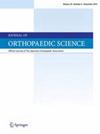Posterior video-assisted trans pedicular surgery for calcified midline thoracic disc herniation
IF 1.5
4区 医学
Q3 ORTHOPEDICS
引用次数: 0
Abstract
Background
In the treatment of patients with calcified midline thoracic disc herniation (CMTDH), the posterior video-assisted transpedicular surgery (VATPS) technique is employed. Both anterior and posterior surgical approaches for treating CMTDH carry a significant risk of surgical complications and potential morbidity. This technical note introduces a surgical procedure that avoids the drawbacks associated with these approaches.
Methods
The VATPS technique presents a comprehensive approach for treating thoracic disc herniation, combining both microscopic and endoscopic stages. The microscopic phase entails a small thoracoscopic incision, muscle release, hemilaminotomy, facet joint resection, and vertebra removal, culminating in creating a corpectomy cavity for endoscope access. Careful separation of adhesions between the dura and ligaments marks this stage. Transitioning to the endoscopic phase, an endoscope is inserted into the cavity, allowing for precise visualization and separation of residual adhesions, removal of calcified disc fragments using specialized instruments, and ensuring complete discectomy.
Results
Fourteen patients underwent VATPS for CMTDH. During the procedure, evoked responses were reduced in one patient. However, no postoperative neurological deficits were observed. We also noted significant improvements in the Oswestry Disability Index (ODI) and the Visual Analog Scale (VAS) scores when comparing the preoperative and postoperative assessments.
Conclusion
VATPS, a minimally invasive technique, offers excellent anterior visibility comparable to that of the anterolateral approach, all while avoiding the adverse effects associated with thoracotomies and the complications resulting from spinal cord encroachment often seen in the posterolateral approach. Moreover, it is a safer alternative to conventional endoscopic posterior thoracic surgery. The cavity formed within the vertebral corpus provides ample working space for the use of an endoscope.
后路视频辅助经踏板手术治疗钙化的中线胸椎椎间盘突出症。
背景:在治疗胸椎中线钙化椎间盘突出症(CMTDH)患者时,采用了后路视频辅助经椎管手术(VATPS)技术。治疗 CMTDH 的前路和后路手术方法都有很大的手术并发症和潜在发病风险。本技术说明介绍了一种可避免这些方法相关弊端的手术方法:VATPS技术是一种治疗胸椎椎间盘突出症的综合方法,结合了显微镜和内窥镜两个阶段。显微阶段包括胸腔镜小切口、肌肉松解、半椎板切开术、面关节切除术和椎体切除术,最后创建一个用于内窥镜进入的椎间盘切除腔。仔细分离硬脊膜和韧带之间的粘连是这一阶段的标志。在过渡到内窥镜阶段时,将内窥镜插入腔内,以便精确观察和分离残余粘连,使用专业器械切除钙化的椎间盘碎片,并确保椎间盘切除术的彻底性:14名患者接受了VATPS治疗CMTDH。在手术过程中,一名患者的诱发反应减弱。但术后未发现神经功能缺损。对比术前和术后的评估结果,我们还发现奥斯韦特里残疾指数(Oswestry Disability Index,ODI)和视觉模拟量表(Visual Analog Scale,VAS)评分有明显改善:结论:VATPS 是一种微创技术,具有与前外侧入路相媲美的良好前方可视性,同时避免了开胸手术带来的不良影响以及后外侧入路经常出现的脊髓侵犯并发症。此外,与传统的内窥镜后胸腔手术相比,这种方法更为安全。椎体内形成的空腔为内窥镜的使用提供了充足的工作空间。
本文章由计算机程序翻译,如有差异,请以英文原文为准。
求助全文
约1分钟内获得全文
求助全文
来源期刊

Journal of Orthopaedic Science
医学-整形外科
CiteScore
3.00
自引率
0.00%
发文量
290
审稿时长
90 days
期刊介绍:
The Journal of Orthopaedic Science is the official peer-reviewed journal of the Japanese Orthopaedic Association. The journal publishes the latest researches and topical debates in all fields of clinical and experimental orthopaedics, including musculoskeletal medicine, sports medicine, locomotive syndrome, trauma, paediatrics, oncology and biomaterials, as well as basic researches.
 求助内容:
求助内容: 应助结果提醒方式:
应助结果提醒方式:


